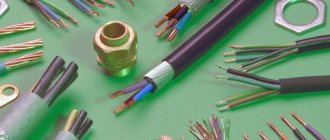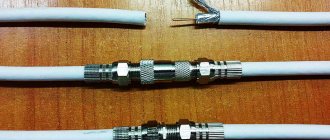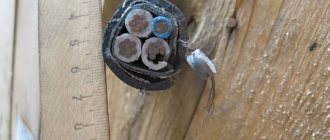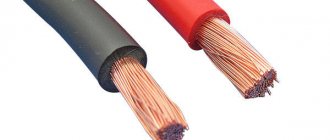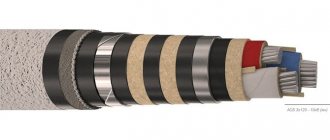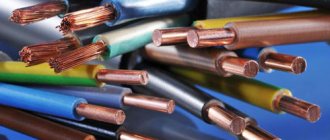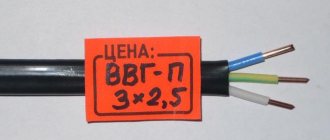Cable laying is not just unwinding conductor products along its future route - it is a rather complex technological process that requires the use of various mechanical devices and devices. There are several unwinding methods, each of which involves lifting the drum above the surface level by at least 0.2 m, and the cable should come off from above. This is an important condition, because the conductor (especially in armored braiding) can bend in an arc, which, resting against the base, will interfere with the rotation of the drum. In this article we will tell you how to unwind a cable from a drum/coil and look at the main methods.
Basic unwinding methods
Depending on the cross-section of the cable, its rigidity, and the presence of a protective sheath, its unwinding is carried out using movable, stationary or manual mechanisms. They must ensure lifting of the drum and its free rotation, eliminating the breaking load on the conductor.
Thus, the process can be carried out using:
- special trailer (cable conveyor);
- an ordinary vehicle (car, tractor);
- winches (electrically driven, manual);
- manually (over short distances).
These methods are the most commonly used, and each of them needs more detailed study.
Use of specialized equipment
Trailers for transporting and laying cables are effectively used to place the conductor in an open manner or by placing it in the ground (prepared trenches - routes). It is especially practical to use when working with products in a rigid and armored protective shell.
| Advantages | Flaws |
| Indispensable for long-distance installations | Inability to use inside buildings |
| Load capacity up to 3-4 tons | Expensive |
| Possibility of placing from 1 to 3 coils simultaneously |
The cable conveyor is used for transporting drums with cable and for unwinding the conductor during its laying.
The only disadvantage of special trailers is their considerable cost. Therefore, the main users of this technology are enterprises specializing in large volumes of work.
Vehicle use
A common practice is to unwind the cable using a machine or tractor. There are two possible options:
- The drum is installed on a metal structure that allows it to rotate freely in the body or on a carriage. The free end is securely fixed at the beginning of the line, and unwinding occurs as the vehicle moves to its destination
- The drum is installed and secured on a rotating device, and the free end of the cable is attached to the car, which produces tension.
| Advantages | Flaws |
| Simplicity and accessibility of the method | The need for additional structure to rotate the drum |
| Significant load capacity | Difficulties with loading and unloading |
| Applicability of different options |
Practical advice: constant control over the unwinding process is mandatory to avoid damage to the product.
Cable unwinding from the machine can be carried out over long distances subject to constant monitoring
Application of unwinding winch
This option is very convenient in terms of practicality, but it limits actions over long distances, which are limited by the length of the cable on the winch. The versatility of the method lies in the possibility of laying a conductor through pipes or cavity structural elements, as well as its applicability for both horizontal and vertical pulling. In addition, with vertical unwinding, movement can be made in any direction - from above or from below.
| Advantages | Flaws |
| Ease and simplicity of the process | Inability to use over long distances |
| Ability to work in different planes and angles of inclination | The need to use guide rollers |
| Availability of installation through holes, openings, pipes | |
| Applicability inside buildings |
Carrying out work manually
Manual unwinding is similar to the previous method of working with a winch, but is significantly limited by the distance, which when working with heavy products can be a little more than 20 m. Very often this method is combined with other methods. That is, the cable is pulled by hand through some structure or cavity, and further tension is carried out by a mechanism.
Unwinding the cable by hand can be done in different ways, but it is limited in length
Unwinding devices
If you need to constantly unwind the drum, then it makes sense to buy special devices that are designed for this. They will make life easier and help you get the job done quickly and efficiently. We will highlight several of the most popular devices:
Haupa 143404 – allows you to unwind cable from coils
Uniroller-100 – unwinds cable reels
The machine UPK 25РЧ002 is intended for cable rewinding
A trolley is one of the easiest ways to unwind a cable.
We also recommend reading:
Devices for unwinding cable and wire products
The devices on which the drum is placed for unwinding the cable from it can be very simple, made in the form of a metal structure of thrust posts and a crossbar located between them, on which the reel is placed. Complex devices can also be used, combining units and mechanisms that facilitate the process of pulling even from large and heavy reels.
Drum unwinder UNIROLLER 500 rol 90101
UNIROLLER 500 device is a compact cable unwinder from small drums weighing up to 140 kg.
Lightweight mobile device for unwinding coils weighing up to 140 kg with a small diameter. The model is equipped with four rollers, with the help of which it can move independently along with the cable reel placed on it. The weight of the product is 8 kg with dimensions: length 53 cm, width 55 cm, height 10 cm.
The device is perfect for indoor use, as well as in the back of a truck or the interior of a utility vehicle. The rotation of the coil is carried out using two durable rollers on which it is installed. The average market price of the product in online stores is 21,000 rubles.
Drum unwinder UNIROLLER 700 rol 90102
This design is used to work with cable reels with a diameter from 0.5 m to 1.8 m and a weight of up to 1.5 tons. It consists of two parts, which are small in size and can be easily delivered to the installation site by any transport. The device can be used even in very cramped conditions. Dimensions are 120.6x27.7x19.5 cm (length-width-height), total weight - 34 kg (each part - 17 kg).
The rotation of the drum occurs due to bearings built into the base of the product, and its lifting and braking is carried out using special levers. The estimated cost in the online store is 155,000 rubles.
The UNIROLLER 700 device is a cable unwinder from drums weighing up to 1.5 tons, with a diameter of up to 1.8 meters. The product can be used inside buildings, as well as outdoors, when installed on a flat, hard surface.
Model UNIROLLER 900 rol 90121
The device with a hydraulic lift is designed for winding and unwinding cable products from drums with a diameter of up to 2.2 m, weighing up to 6.0 tons. It consists of a pair of metal supports, each equipped with two wheels and a hydraulic lifting device. Between them there is a pipe that acts as an axis for hanging the coil. The height of each support is 112 cm, weight – 45 kg. Axle length 185 cm.
The hydraulic lifts are operated by a foot drive. The universal design can be used on any site that has a sufficiently flat, hard surface that can withstand the weight of the cable drum. Additionally, the device can be equipped with an axle 150 cm long, which will expand the range of serviceable drums. The cost of the device in the online store is about 299 thousand rubles.
The design of UNIROLLER 900 is suitable for working with large and heavy cable drums weighing up to 6.0 tons
Types of cable winding reels
Drums are special devices for transporting, storing and laying electrical cables. Wood, mainly coniferous species, is used to make products. There are also drums made of metal or aluminum, as well as electric ones that can automatically wind wire, which is important for long product lengths.
Cable in industry and construction is supplied on drums whose diameter is at least 40 times the nominal outer diameter of the cable. The drum design has several parts:
- Cheek (1). On one of the cheeks of the drum, a hole must be provided for the cable exit. Depending on the drum number, it can range from 30 to 130 mm. The output cable is pressed tightly to the cheek and sewn up with a metal sheet 0.5 mm thick and 20-50 mm wide.
- Bushing (2). A part with an axial hole into which the mating part fits.
- Hairpin (3). A fastener in the form of a rod with an external thread.
- Neck circle (4) and neck (5). The part of the drum on which cable and wire products are wound.
- Sheathing (6). Usually it is a continuous row of boards. Upon request, the cladding can be done at intervals of one board.
Thus, the drum (coil) is a combination of two jaws connected by a round bushing. To strengthen the structure, the cheeks are tightened with bolted rods.
The drum number (from 5 to 30a) indicates the diameter of the cheek in decimeters. The dimensions of drums of a certain number and parts included in the kit in disassembled form must correspond to those presented in the table.
| Drum number | Diameter, mm | Length, mm of neck | Sheathing length | Drum weight with casing, kg | Number of studs | ||
| cheeks D | cervix D1 | axial hole d | |||||
| 5 | 500 | 200 | 35 | 230 | 306 | 18 | 3 |
| 6 | 600 | 200 | 35 | 250 | 326 | 25 | 3 |
| 8 | 800 | 450 | 50 | 230 | 306 | 40 | 4 |
| 8a | 800 | 450 | 50 | 400 | 476 | 50 | 4 |
| 86 | 800 | 450 | 50 | 500 | 576 | 70 | 4 |
| 10 | 1000 | 545 | 50 | 500 | 600 | 90 | 4 |
| 10a | 1000 | 500 | 50 | 710 | 810 | 100 | 4 |
| 12 | 1220 | 650 | 70 | 500 | 700 | 120 | 4 |
| 12a | 1220 | 650 | 70 | 710 | 826 | 120 | 4 |
| 126 | 1220 | 600 | 70 | 600 | 616 | 120 | 4 |
| 14 | 1400 | 750 | 70 | 710 | 716 | 190 | 6 |
| 14a | 1400 | 900 | 70 | 500 | 850 | 165 | 6 |
| 146 | 1400 | 1000 | 70 | 600 | 1016 | 210 | 6 |
| 14v | 1400 | 750 | 70 | 710 | 716 | 220 | 6 |
| 14g | 1400 | 750 | 70 | 900 | 916 | 230 | 6 |
| 16 | 1600 | 1200 | 70 | 600 | 890 | 290 | 6 |
| 16a | 1600 | 800 | 80 | 800 | 1040 | 300 | 6 |
| 17 | 1700 | 900 | 80 | 750 | 1060 | 325 | 6 |
| 17a | 1700 | 900 | 80 | 900 | 1260 | 350 | 6 |
| 18 | 1800 | 1120 | 80 | 900 | 810 | 485 | 6 |
| 18a | 1800 | 900 | 80 | 900 | 600 | 485 | 6 |
| 186 | 1800 | 750 | 80 | 1000 | 1260 | 520 | 6 |
| 18c | 1800 | 900 | 80 | 730 | 1290 | 540 | 6 |
| 20 | 2000 | 1220 | 80 | 1000 | 1180 | 700 | 6 |
| 20a | 2000 | 1000 | 80 | 1060 | 1240 | 690 | 6 |
| 206 | 2000 | 1500 | 80 | 1000 | 1180 | 800 | 6 |
| 22 | 2200 | 1320 | 100 | 1000 | 1236 | 950 | 8 |
| 22a | 2200 | 1480 | 100 | 1050 | 1286 | 1000 | 8 |
| 226 | 2200 | 1680 | 100 | 1100 | 1336 | 1020 | 8 |
| 22v | 2200 | 1320 | 100 | 1100 | 1386 | 1000 | 8 |
| 25 | 2500 | 1500 | 120 | 1300 | 1560 | 1470 | 8 |
| 26 | 2650 | 1500 | 120 | 1500 | 1780 | 1700 | 8 |
| 30 | 3000 | 1800 | 150 | 1800 | 2160 | 2700 | 10 |
| 30a | 3000 | 2500 | 150 | 1700 | 1892 | 2600 | 10 |
On the cheek where the hole for the cable exit is made, the following inscriptions and designations must be provided:
- an arrow indicating the direction of rotation of the drum when rolling;
- “Ride along the arrow”;
- “Do not lay flat”;
- “Do not dump when unloading.”
Important! The unwinding direction in the direction of the arrow is observed only when moving by rolling. If the cable is unwinding from a drum mounted on jacks, the rotation is in the direction opposite to that indicated by the arrow.
On the cheek of the drum opposite the one with the hole, indicate:
- manufacturer's name or trademark;
- cable brand;
- number of cores and their nominal cross-section (mm2);
- length (m), gross weight (kg) and voltage (kV);
- drum serial number;
- release date (year and month);
- GOST or TU number for cable manufacturing.
When deciding to buy a cable , pay attention to the presence of an electrical test report. It is applied to the drum and placed in a waterproof bag on the inner cheek.
Using a cable unwinding crane
When carrying out work on construction and installation sites where there are cranes or access by motor vehicles, in particular a truck crane, is possible, unwinding of cable and wire products is allowed using them. To do this, it is necessary to correctly sling the coil through the pipe, which will play the role of a giving axis.
The advantages of this method are:
- applicability for working with any weight of cable drum;
- the ability to climb to the desired floor;
- permissibility of work in both horizontal and vertical planes.
The main condition for using cranes for unwinding cable and wire products is reliable lashing, which prevents the drum from falling. However, unwinding a cable directly from a suspended drum is done extremely rarely and in the most exceptional cases. The main purpose of a crane (beam crane, hoist) is to place the reel on the racks.
Unwinding devices
If you need to constantly unwind the drum, then it makes sense to buy special devices that are designed for this. They will make life easier and help you get the job done quickly and efficiently. We will highlight several of the most popular devices:
Haupa 143404 – allows you to unwind cable from coils
Uniroller-100 – unwinds cable reels
The machine UPK 25РЧ002 is intended for cable rewinding
A trolley is one of the easiest ways to unwind a cable.
We also recommend reading:
Features of cable unwinding at subzero temperatures
There are brands of conductors whose insulation is made specifically for northern climatic conditions. Such products are allowed for installation at temperatures down to -50 °C. However, the majority of products lose their insulation elasticity at negative ambient temperatures, which can lead to damage during installation. Therefore, it is not recommended to carry out such work in winter.
If the need for unwinding nevertheless arises, then any manipulations with the wire should be preceded by warming it up. It is carried out either indoors or in a heated tent where the bay is placed. The duration of warming up directly depends on the temperature achieved:
- +5-10°С – at least 3 days;
- +10-25°С – at least 1 day;
- +25-40°C – 18 hours is enough.
In addition, the cable can be heated using three-phase current. The electric current passed through the coil for heating should not exceed 75% of the permissible value for the conductor brand and core cross-section. It is also necessary to monitor the temperature of the outer cover of the insulation - it should not rise more than 20°C .
Cable jacks for winding and unwinding
According to the operating principle, jacks used for unwinding or winding cables are divided into:
- hydraulic, operating due to fluid pressure inside the working cylinder;
- threaded, which feed by moving the screw along the thread through the nut;
- lever, working on the principle of a lever, using the difference in the length of the cradle and the main arm.
You can consider the effect of structures using specific examples:
- Model DG 20 (hydraulic jack). Purpose – work with cable drums D 2-3.5 m, weighing up to 20 tons. Device weight – 520 kg
- Model DV 26-5 (screw jack). Purpose – lifting for unwinding reels of cable D 0.8-2.6 m, weighing 5 tons. Device weight 180 kg
- Mechanical (lever) models are mainly used for lifting small weight drums and then placing them on racks.
Screw cable jack allows you to lift the drum above ground level for unwinding and laying cables
Making a jack with your own hands
A jack for hanging cable drums can be made independently, subject to certain conditions. To create such a design, you will need a channel, a thick-walled pipe D 50 mm, two M 22 threaded studs 40-50 cm long, 2 M 22 nuts, and a welding machine.
- 50 cm long pipe is welded to a section of channel 60 cm long, in the middle at an angle of 90 °
- A sleeve is welded into the upper part of the pipe so that the screw, passing tightly through its hole, is placed inside the pipe
- A piece of channel is welded to one end of the screw, forming a bed
- A nut with a collar welded to it is screwed onto the other end of the screw, up to the stock.
- The free end of the stud is placed in the sleeve and lowered into the pipe
- The second rack is made in the same way
- For greater stability, additional stops can be welded to the sides of the pipe.
- A pipe is placed on the stock between the two posts and threaded into the hole of the drum. By rotating the nuts using cranks, the studs move out of the pipes, lifting the crossbar with the coil.
Practical advice: It is not recommended to use homemade jacks for lifting large, heavy bobbins weighing more than a ton. For these purposes, industrial products are used that are designed for a certain load in design bureaus.
